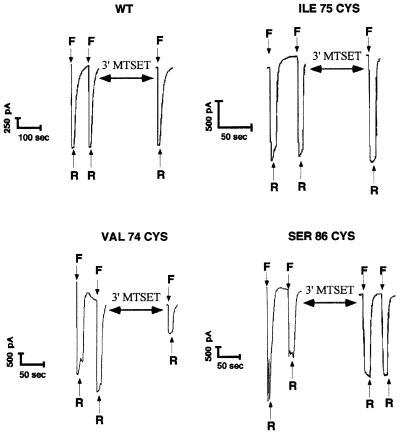Fig. 2.Susceptibility of wild-type FaNaC and several mutants to 1 mM MTSET. Positive transfectants in the whole-cell clamp configuration were maintained at –40 mV. Bath and pipette solutions were of identical composition (140 mM NaCl, 10 mM HEPES, 1 mM CaCl2pH 7.4). Cells were briefly perfused twice with the same solution containing 30 µM FMRF-amide to determine the maximal amplitude of the stimulation (Imax) before being rinsed until the baseline current was reached, and then perfused with 1 mM MTSET in the same solution for 3 min. The third peak corresponds to the channel stimulation by 30 µM FMRF-amide after 3 min of MTSET application followed by 1 min of rinse. In these conditions, the wild-type channel (WT) and mutants such as Ile75Cys are not affected by 1 mM MTSET, while mutants such as Val74Cys show a marked inhibition. Note that the Ser86Cys mutant, which exhibits a strong desensitization upon FMRF-amide repeated stimulations, regains activity and does not desensitize following 3 min of 1 mM MTSET exposure. F, 30 µM FMRF-amide; R, rinse.

An official website of the United States government
Here's how you know
Official websites use .gov
A
.gov website belongs to an official
government organization in the United States.
Secure .gov websites use HTTPS
A lock (
) or https:// means you've safely
connected to the .gov website. Share sensitive
information only on official, secure websites.
